Table of contents
- Comparative test of protector vests Relapse rate
- Alpinestars Bionic SP Vest
- BMW back protector 2
- Buse Belluno
- Dainese Gilet Wave 2-3 Neck
- Hein Gericke Safety Vest
- Hero Salvo
- Hero stout
- IXS Garuda
- Shock absorption
- Polo Safe Max
- Rukka APS air
- Vanucci protector vest
- Buy right
- Conclusion
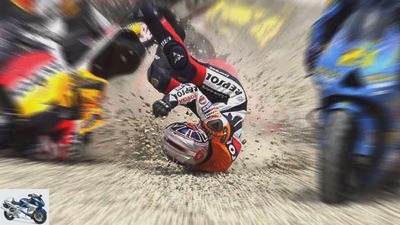
2snap
clothing
Comparative test of protector vests
Comparative test of protector vests
Relapse rate
If you dare too much, you will quickly torpedo yourself in the fight on the last groove. But the following applies not only in racing: In the event of an accident, the back is particularly at risk and should be protected accordingly. For example with a protector vest. MOTORRAD tested eleven candidates in the laboratory and in practice.
Holger Hertneck
12/20/2007
Not every leather suit or textile jacket has adequate back protection as standard. Often there are only soft foam mats in the protector pockets, the protection against accidents tending towards zero. If you want to protect your back properly while riding a motorcycle, you cannot avoid a separately worn, CE-approved protector.
So-called protector vests have become increasingly popular in recent years? sleeveless overcoat with integrated back protector. Your advantage over conventional back protectors: comfortable to wear, non-slip fit and comfortable handling. Eleven candidates from different providers are compared. Including four almost identical vests from Buse, hero (Salvo), polo and Vanucci, all of which are equipped with protectors from the manufacturer Komperdell. The BMW model is the only one in the test that does not have a front zipper, but rather a chest strap attached to straps and a kidney belt for securing it. With the exception of the Garuda from Ixs, all of them generally fit under textile and leather clothing. Only under tightly cut leather suits can it be when wearing voluminous models or those with integrated chest protection ?? such as from Alpinestars or Dainese ?? close to. What to look out for when buying is in “Buy correctly”.
The maximum of 100 points to be achieved are distributed as follows among the criteria taken into account in the laboratory and in practice.
Shock absorption (30 points): MOTORRAD examined the most important criterion together with TuV Rheinland in Cologne, closely following the CE standard 1621-2 for back protectors (see »Shock absorption«).
Effective protection area (15 points): The shock absorption according to CE only requires that the protector complies with the prescribed limit values in the specified protection zone. MOTORRAD also evaluates the actual size of the protected area. In this regard, for example, the model cuts through Rukka with its very narrow protector does less well than the Garuda vest from Ixs with its large back protector. A maximum of twelve of the 15 points in this criterion are attributable to the protector itself, the remaining three points can be collected by the candidates for additional accident protection. Thanks to sturdy plastic shells in the chest and shoulders as well as the high neck protection, the Dainese is the only one to receive all three.
Wearing behavior (25 points): How well do the vests fit, how tightly and how secure are they? The protectors should be soft and supple when riding and neither cause pressure points nor make the wearer feel as if they have a board in their back. The topic of ventilation also plays a role here. The most breathable are the candidates from Dainese and Rukka, whose back protectors are made of open-pored materials.
Handling (10 points): Here, all eleven test subjects do quite well, as they can be put on and taken off easily without the hassle of fiddling around. The best way to do this is with the Alpinestars model, in which the Velcro strap on the stomach does not extend over the front zip, which makes it ?? once the waist size has been adjusted ?? always fits. There’s full marks for that. The Safety Vest from Hein Gericke, with which only one front zip can be operated, also receives this.
Workmanship (10 points): The most expensive vest by far in the test, the Rukka APS air, is brilliantly processed. Every seam fits, there are no bulges. High-quality textile materials round off the good impression.
Weight (5 points): The lightest model, the Safety Vest from Hein Gericke, weighs 678 grams, just half as much as the heaviest, the Garuda from Ixs. A characteristic that sooner or later becomes noticeable when driving and is included in the rating.
Marking (5 points): According to the CE standard, protectors must be clearly marked (see also box on page 65). The practice looks partly different. Points are deducted for incorrect or missing information. After all, customers in the store should be able to understand what they are buying by means of labeled patches or legible embossing.
Buy complete article
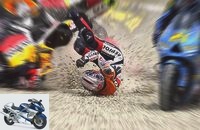
Comparative test of protector vests
Relapse rate
8 pages) as PDF
€ 2.00
Buy now
Alpinestars Bionic SP Vest

Bilski
The protective vest from Alpinestars offers not only the large back shell, but also additional plastic shells in the chest area.
Providers:
Alpinestars, phone 0039/0423/5286, www.alpinestars.com Price: 169.95 euros; Sizes: S to XXL; Weight *: 1154 grams; CE level: 2
plus
Plastic shells in the chest area as additional protection against accidents; lies clean and free of pressure points on the body; comfortable to wear, freedom of movement not restricted; smart waist belt construction (Velcro straps do not run over the front zipper), thus perfect handling; Protector element can be removed for cleaning the vest; full CE marking
minus
Four beats just above the CE limit for level 2
Conclusion
The SP Vest does not meet the high self-imposed requirements for security level 2. With an average residual force of around 13 kilo-newtons (kN) ?? not a bad value in absolute terms ?? if it is four kN above it. Positive: the large plastic shells in the chest area for additional accident protection. However, it can be tight under tight leather suits.
MOTORRAD verdict: Good
BMW back protector 2
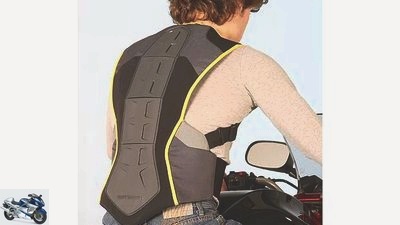
Bilski
The back protector from BMW offers good workmanship and comfort, but with too high a residual force value for shock absorption, it is above the permissible limit value.
Providers:
BMW, Telephone 0180/5001972, www.bmw-motorrad.de Price: 140 euros; Sizes: S to XL; Weight *: 1048 grams; CE level: 2
plus
Except for one stroke, good shock absorption values; Hip and collarbone pads as additional accident protection; good handling; Waist belt with large adjustment range; very well processed; Complete CE marking except for small defects in form
minus
One stroke well above the CE limit for level 2; Click fastening of the chest strap can lead to pressure points under tight-fitting leather suits; Protector cannot be removed or removed for cleaning
Conclusion
The weakness in the shock absorption with a residual force value well above the permissible limit disturbs the otherwise good impression of the back protector 2. In all other criteria, especially in the processing, the BMW protector leaves a good impression.
MOTORRAD verdict: Good
Buse Belluno
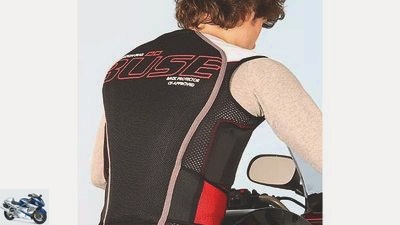
Bilski
The MOTORRAD test winner presents itself with the best shock absorption values and a high level of comfort.
Providers:
Buse, phone 02471/12690, www.buese.com Price: 169.95 euros; Sizes: S to XL; Weight *: 932 grams; CE level: 2
plus
The best shock absorption values in the test, protection level 2 clearly passed; very large back protector, which also covers the shoulder blades; Coccyx and rib pads as additional protection against accidents; good handling; Protector element can be removed for cleaning the vest; pleasantly light
minus
The waist belt falls out a little too far; CE marking illegible
Conclusion
Conceivably just before the almost identical models from Held, Polo and Louis, the Belluno secured the test victory. The difference is the slightly lower weight in comparison. The protector vest shines with brilliant shock absorption values on the test bench and can be worn comfortably under textile and leather suits. Apart from a label that could be improved, it does not give rise to any criticism.
MOTORRAD verdict: very good
Dainese Gilet Wave 2-3 Neck
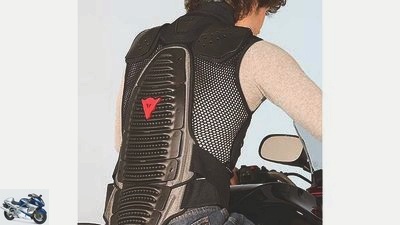
Bilski
With the Gilet Wave from Dainese, it’s not just comfort that leaves a lot to be desired.
Providers:
Dainese, phone 089/35827270, www.dainese.com Price: 250 euros; Sizes: S to XL; Weight *: 1070 grams; CE level: 1
plus
Plastic shells in the chest, shoulder and neck area as additional protection against accidents; particularly breathable due to the open honeycomb construction of the protector; very good handling; full CE marking
minus
Weakness in shock absorption after CE; the effective protection area of the back protector is very narrow; limited wearing comfort due to the many plastic shells, pressure point on the neck area; Protector cannot be removed for cleaning
Conclusion
When checking the two freely selectable potential vulnerabilities according to the CE standard, one actually turned out to be such. Numerous plastic shells also limit the space under leather suits and the wearing comfort. The wave vest is most suitable for off-road use due to the hard shell that protects against punctures.
MOTORRAD verdict: satisfying
Hein Gericke Safety Vest
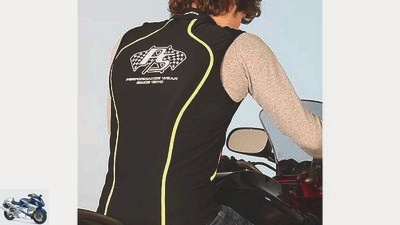
Bilski
Attractive: The Safety Vest from Hein Gericke is pleasantly light to wear and impresses with its quality and price.
Providers:
Hein Gericke, phone 0211/98989, www.hein-gericke-store.com; Price: 99.95 euros; Sizes: S, M, L; Weight *: 678 grams; CE level: 2
plus
Good shock absorption values; large back protector, which also covers parts of the shoulder blades; comfortably light without any pressure points; perfect handling; well processed; Protector element can be removed for cleaning the vest; very easy; full CE marking
minus
Two strokes just above the CE limit for level 2; no waist belt for better fixation available
Conclusion
The cheapest vest in the test has a large protector, which has decent shock absorption values, even if it just misses the high target, protection level 2, that it has set itself. The no-frills Safety Vest lies cleanly and completely pressure-free on the body and is great under textile and leather suits.
MOTORRAD verdict: very good
Hero Salvo
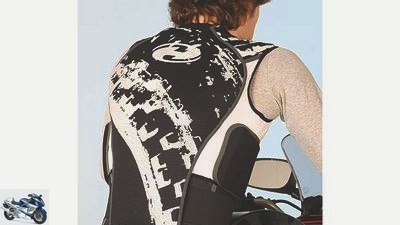
Bilski
The protector vest “Salvo” von Held not only offers the best shock absorber qualities, but also a high level of comfort.
Providers:
Held, phone 08321/66460, www.held-biker-fashion.de; Price: 159.95 euros; Sizes: S to XXL; Weight *: 1166 grams; CE level: 2
plus
Excellent shock absorption values, protection level 2 clearly passed; very large back protector, which also covers the shoulder blades; Coccyx, rib and collarbone pads as additional protection against accidents; good handling; Removable protector element for cleaning the vest
minus
Waist belt with interrupted Velcro adjustment range; CE marking illegible
Conclusion
The Salvo is characterized by excellent shock absorption values and a high level of wearing comfort, and its unusual coloring also sets it apart from the competition.
MOTORRAD verdict: very good
Hero stout
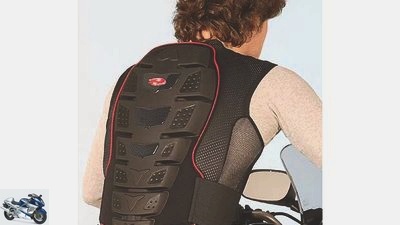
Bilski
Safe, inexpensive and with a weight of only 770 grams also comparatively light: the protector vest “stout” of hero.
Providers:
Held, phone 08321/66460, www.held-biker-fashion.de; Price: 119.95 euros; Sizes: S to XXL; Weight *: 770 grams; CE level: 2
plus
Very good shock absorption values, protection level 2 passed; very good handling; Waist belt with large adjustment range; very easy; full CE marking
minus
A stiff Velcro strap can lead to pressure points if the driver is in the front-wheel drive position; comparatively hard, stiff protector (turtle feeling); Protector cannot be removed for cleaning
Conclusion
Noticeably light, simply made protector vest that fits under almost all textile and leather suits, shines with great shock absorption values and has only a few weaknesses in detail. Also positive: the comparatively low price.
MOTORRAD verdict: Good
IXS Garuda
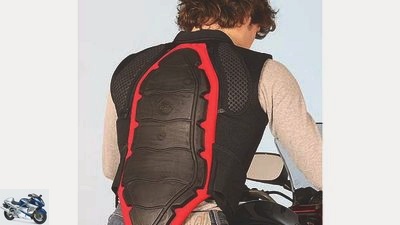
Bilski
The voluminous protector vest from IXS creates a real turtle feeling.
Providers:
Hostettler, phone 07631/18040, www.ixs.com; Price: 159.90 euros; Sizes: S to XL; Weight *: 1360 grams; CE level: 1
plus
Good shock absorption values, protection level 1 easily passed; very good handling; Removable protector element for cleaning the vest
minus
Wide, stiff Velcro strap can lead to pressure points when the driver is in a front-wheel-oriented position; low air permeability of the entire vest; comparatively heavy, voluminous and stiff protector (turtle feeling); incomplete labeling
Conclusion
The most voluminous vest in comparison? not only because of their large, turtle-like protector. The vest is also thicker than the rest. Therefore, there is usually not enough space under leather suits for the Garuda. Noteworthy: the excellent shock absorption values for a protector of protection level 1, which on average are only a good two kN above the permissible limit value of the much more demanding level 2.
MOTORRAD verdict: satisfying
Shock absorption
TuV TESTING
The shock absorption measurements of the test candidates were carried out by MOTORRAD in cooperation with the experts from TuV Rheinland on their drop test bench in Cologne. The tests were carried out in close accordance with the CE standard; size L protectors were tested in each case. The protector manufacturers themselves can choose the waist-shoulder distance that is relevant for calculating the minimum protection zone. This results in minimal differences in the size of the protection zones within which the five test points prescribed by the standard must lie. The results of the measurements including the allocation of points can be found in the adjacent table. In addition to the average residual forces, MOTORRAD also assessed compliance with the protection class specified by the manufacturer (Level 1 or Level 2 – for an explanation, see box on the top right, CE test). There is a deduction for exceeding the relevant limit values. Example: A protector of the more demanding level 2 receives a point deduction for a single hit with a residual force value of 14 kN (permissible single hit: maximum 12 kN). The same residual force value for a level 1 protector, however, does not lead to a deduction of points, as it is still far below the permissible single impact limit of 24 kN.
ce examination
The CE standard EN 1621-2 has been in force for back protectors since July 2003. A central component is a shock absorption test. A rod-shaped body with a mass of five kilograms falls from a height of one meter onto the protector, which rests on a hemispherical anvil with an integrated force transducer. This constellation is intended to simulate the impact on a curb. The five surcharges required by the standard must lie in the cross-shaped, so-called minimum protection zone, which is calculated from the waist-shoulder distance specified by the protector manufacturer. Three of the five impacts are clearly defined (see shock absorption table below), the examiner must place two individual impacts on freely selectable potential weak points within the marked protection zone. A special feature of EN 1621-2 is the distinction between two protection classes. The manufacturer decides to which the respective protector belongs. The average residual force for protectors of level 1 must not be more than 18 kilo-Newtons (kN) and no single blow must exceed 24 kN. For level 2, the maximum permissible values are 9 kN (average residual force) and 12 kN for a single blow. A back protector certified according to level 2 offers better shock absorption values and thus higher protection.
LABELLING
In addition to certain shock absorption limit values, the CE standard requires the back protector to be fully labeled. It does not matter whether this is done by embossing, printing or patches. It is only important that the marking is firmly connected to the protector. In the case of protector vests with removable cushioning inserts, the label must be attached directly to the protector. External markings are only sufficient for vests with firmly sewn back protection. Complete labeling includes: name of the manufacturer (a), model or type designation (b), information on the standard (c), which for back protectors must be CE EN 1621-2, pictogram of a motorcyclist (d) with the abbreviation »B« (for back = back) and a note on the performance level (level 1 or 2). Also mandatory: the indication of the waist-shoulder distance in millimeters or centimeters (e). The size of the protection zone valid for the test is calculated from this length.
Polo Safe Max
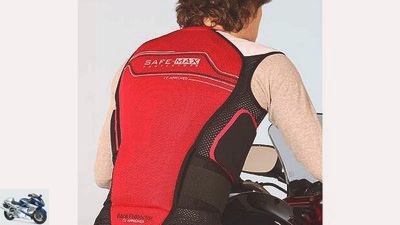
Bilski
The large Safe Max from Polo proves to be an excellent shock absorber in the test.
Providers:
Polo express delivery, phone 0211/9796699, www.polo-motorrad.de Price: 129.95 euros; Sizes: M, L, XL; Weight *: 1110 grams; CE level: 2
plus
Excellent shock absorption values, protection level 2 clearly passed; very large back protector, which also covers the shoulder blades; Coccyx, rib and collarbone pads as additional protection against accidents; good handling; Removable protector element for cleaning the vest
minus
Waist belt with interrupted Velcro adjustment range; CE marking illegible
Conclusion
Due to its excellent shock absorption values and high level of comfort, the very cheap vest, which apart from the illegible CE marking, has no noticeable weaknesses, is recommended to buy. In addition, the Safe Max is also pleasantly noticeable in terms of color, although this has no influence on the rating.
MOTORRAD verdict: very good
Rukka APS air

Bilski
Too bad. Despite the good workmanship, the protector vest from Rukka cannot achieve a good test result.
Providers:
Rukka, phone 040/5511055, www.rukka.com Price: 399.99 euros; Sizes: S, M, L; Weight *: 1028 grams; CE level: 1
plus
Fixed non-slip thanks to the crotch strap; comparatively breathable due to open-pored protector insert; excellently processed; Removable protector element for cleaning the vest
minus
Only moderate shock absorption values, protection level 1 just missed; effective protection area of the back protector comparatively narrow; a bit laborious to put on due to the double crotch strap; Incomplete labeling, including missing information on torso length and protection level
Conclusion
Good fixation, perfect workmanship and some breathability alone are not enough for a good test result. The fact that by far the most expensive vest in the test even fails just under protection level 1 is weak. Anyone who takes so much money into their hands demands significantly more in return.
MOTORRAD verdict: satisfying
Vanucci protector vest
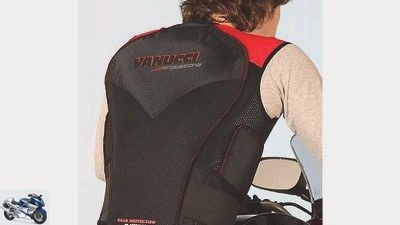
Bilski
The protector vest from Vanucci has earned the MOTORCYCLE buyer’s tip.
Providers: Louis, Telephone 040/73419360, www.louis.de Price: 139.95 euros; Sizes: S to XL; Weight *: 1092 grams; CE level: 2
plus
Excellent shock absorption values, protection level 2 clearly passed; very large back protector, which also covers the shoulder blades; Coccyx, rib and collarbone pads as additional protection against accidents; good handling; Removable protector element for cleaning the vest
minus
Waist belt with interrupted Velcro adjustment range; CE marking illegible
Conclusion
The high level of comfort, easy handling and excellent shock absorption values characterize the large protective Vanucci protector vest that fits under leather and textile clothing. The only notable weakness, a badly legible CE mark. For a good overall impression, there’s a MOTORCYCLE buying tip.
MOTORRAD verdict: VERY GOOD
Buy right
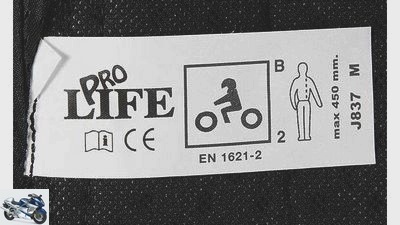
Bilski
You should definitely not forget to look at the CE marking.
When buying a protector vest, you should first pay attention to the CE standard (CE EN 1621-2). But the best protector is of no use if it doesn’t fit snugly and securely against the body. He should especially do this in the riding position on the motorcycle, so not just try on the vest in the shop, but also try to sit in full gear with a driving suit and helmet. This shows whether the protector is too short or too long, presses against the helmet, rests on the seat or possibly doesn’t even fit under the station wagon. It is ideal when the protector generously covers the entire spine from the lumbar area to the neck and, if possible, parts of the shoulder blades also lie under the protective surface.
Conclusion
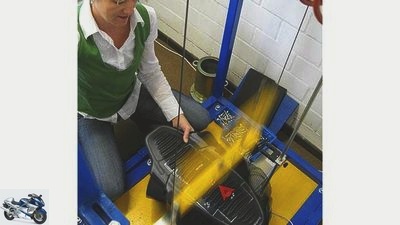
2snap
Shock absorption: TuV expert Christiane Reckter at the drop test stand in Cologne.
An evenly distributed test field with a broad tip ?? this is how the end result is presented. Head to head the almost identical vests from Buse, Held (Salvo), Polo and Vanucci, whose protector inserts from the same manufacturer boast excellent shock absorption values. In stark contrast to the two most expensive candidates from Dainese and Rukka, who are in the last place due to weaknesses in shock absorption. After all, none of the participants in the present test fails completely.
Related articles
-
Comparative test of back protectors, protector vests and protector shirts for motorcyclists
Dentges 29 pictures mps photo studio 1/29 Alpinestars Nucleon KR-1 (MOTORRAD test winner). mps photo studio 2/29 BMW back protector. mps photo studio…
-
Comparative test of back protectors
Rettenmayr clothing Comparative test of back protectors Comparative test of back protectors Backing Pressed, it happened. Often, however, other road…
-
Airbag vests put to the test: models from Alpinestars, Dainese and Held
ADAC. 5 pictures ADAC. 1/5 The ADAC has intensively tested three airbag vests for motorcyclists. ADAC. 2/5 Also there was the Alpinestars Tech-Air…
-
Comparative test of textile suits 2012
Jahn clothing Station wagons, jackets & pants Comparative test of textile suits 2012 Product test: upper-class textile suits in comparison The top ten…
-
Comparative test of sports gloves
2snap clothing gloves Comparative test of sports gloves Comparison test: sports gloves handshake Content of Large glove manufacturers can pay dearly for…
-
Comparative test of sintered metal brake pads for Yamaha TDM 850
accesories Comparative test of sintered metal brake pads for Yamaha TDM 850 Comparative test of sintered metal brake pads for Yamaha TDM 850 Record…
-
Comparative test of leather jackets
Artist clothing Station wagons, jackets & pants Comparative test of leather jackets Comparative test of leather jackets True to style With a classic…
-
Comparative test of impregnating agents
jkuenstle.de 11 pictures mps photo studio 1/11 8th place: Bikecare Waterproof, 8.99 euros, MOTORRAD verdict: satisfactory mps photo studio 2/11 7th…
-
Comparative test of winter boots from 150 to 180 euros
Sdun clothing Boots Comparative test of winter boots from 150 to 180 euros Comparative test of winter boots from 150 to 180 euros Touring boots in winter…
-
Comparative test of winter gloves
Hertneck clothing gloves Comparative test of winter gloves Comparative test of winter gloves No question Ride a motorcycle or do you prefer to take the…